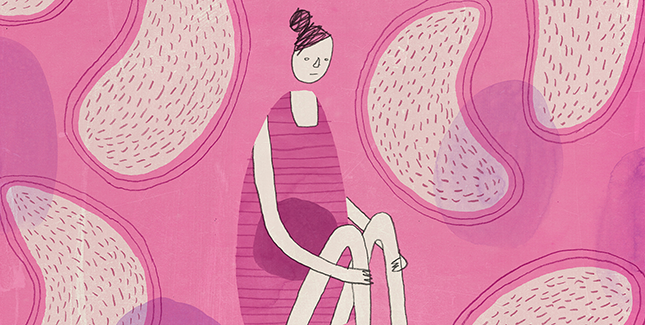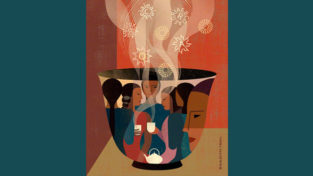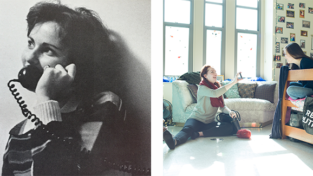My Voice: Becoming My Mother’s Daughter
I am a DES Daughter. DES—diethylstilbestrol—was a synthetic estrogen prescribed to millions of pregnant women, from about 1940 to the early 1970s, in the mistaken belief the drug prevented miscarriage and ensured a healthy pregnancy. Instead, DES harmed the mothers who were prescribed it, their children exposed in utero, and now grandchildren, and possibly beyond. It is estimated that as many as ten million people have been affected.
My DES story began during my sophomore year at Mount Holyoke, but my DES history began in the womb. During midterm exams, I received a frantic phone call from my mother. Between her sobs, she explained that she had taken a medication prescribed by her obstetrician, from the second trimester through the end of her pregnancy with me, to prevent a miscarriage. Her current gynecologist was compelled to look at Mom’s old records because he had recently read about in-utero DES exposure being linked to a rare vaginal and cervical cancer—clear cell adenocarcinoma. A cancer that was only seen in older women was now being diagnosed in young women who were exposed to DES in utero. Mom’s doctor discovered that she had taken DES, and that I might be at risk for cancer. She begged me to rush home to have my first gynecological examination, to see if—and how—I, too, may have been affected. Though completely shaken by the call, I struggled to maintain my composure. I urgently wanted to leave campus and promised to go home after midterms ended. This time became not only a significant permanent memory of my sophomore year at MHC but also a turning point in my life.
As conditions appear, I continue to be an anomaly to my doctors.
Karen Calechman ’78
During my first examination, at age 19, I was found to be a “classic case of DES exposure.” I had a tipped uterus and cervical adenosis (irregularity in the cells lining the cervix). I learned that I would have to be carefully watched for cancer. During a routine gynecological examination a couple years later in Washington, DC, the doctor became excited as he asked if he could invite his interns and residents to view my cervix. I was “a textbook case.” On the verge of tears, my legs in stirrups, I meekly replied yes.
The conditions that I have developed over the years—and that have been proven to be the result of my DES exposure—are numerous, and so far not life threatening, but together they have caused me much harm, anxiety, and fear. I am continually watched and examined by specialists. Besides an incompetent cervix, I have had irregular cervical cells, a miscarriage, and two premature, low birthweight babies. I have twice the risk of developing breast cancer than unexposed women my age. And as new conditions appear, I continue to be an anomaly to my doctors. They exclaim, “But, you are too young to have this,” or “You don’t fit the profile of a patient who would have this condition.”
The emotional toll on me and my family can’t be measured. I have gone from denial to fanatic focus on my health. My mother can’t even speak about DES exposure. It is much too painful for her, and she was not raised to speak up. It wasn’t until I came to Mount Holyoke that I found my voice. I speak loudly now. As I continue to live with the unknowns of DES, I make it a priority to educate the current generation, who will become doctors, researchers, and advocates. I do everything I can to assure that FDA oversight of new medications is stricter than it was for DES. Perhaps most important, I support other DES-exposed individuals by listening to their stories. I feel strongly that it is my responsibility to ensure that we learn from this medical tragedy, so it never happens again.
 Karen Calechman ’78 is an educational and outreach manager. She initiated and led the effort to hold “DES: A Population Health Tragedy,” a symposium held at Mount Holyoke College in March.
Karen Calechman ’78 is an educational and outreach manager. She initiated and led the effort to hold “DES: A Population Health Tragedy,” a symposium held at Mount Holyoke College in March.
This article appeared in the spring 2017 issue of the Alumnae Quarterly.
Have an opinion to share?
Pitch your topic at quarterly@mtholyoke.edu.
April 7, 2017












I too am a DES daughter, born in 1950 and class of ’72. I have had cervical adenosis, a miscarriage, and a son born with multiple urinary abnormalities, who later developed testicular cancer. My mother developed advanced breadt cancer at the age of 32, with no family history, and passed at age 38. My DES-knowledgeable gyn, just retired, had numerous breadt cancer patients among those who took DES. Pleased to hear from other DES daughters/granddaughters as I can share on numerous medical problems and FB support groups. Email nnctrue@gmail.com
Hi Nancy,
Thank you for your kind words and offer to connect. I have emailed you from my personal email address. I would love to speak with you. Please make sure to check your spam so you get my email. I think that we can help others. I am so very sorry for the loss of your mother at such a young age, and for your son’s medical problems. We are working on a collaborative effort between MHC, a professor, and students to capture DES mothers’, daughters’, sons’ and grandchildren’s stories for the Archives. It would be through the lens of gender studies, medicalization of women’s reproduction, and feminist politics. I hope that you will respond to my email and that we can talk soon!
Wishing you health,
Karen
I, too, was given DES when I was pregnant with my second and third children. My second, a daughter, has been monitoring various potential symptoms for years. She is now age 59 and the mother of two college-age sons–both 100% normal. My third child is a son, age 57, and the father of two girls, ages 13 and 9. To the best of our knowledge, both girls are fine and show no symptoms of DES. This is a multiple lifetime watch. The physician who prescribed DES for me moved to another city and is now deceased. My recollection is that he prescribed dialstylbesterol to counter my tendency to have small babies….5 lbs 13 oz and 6 lbs +. I suspect that every story will be a bit different.
Thanks so much for this article. My mother took DES in 1974. I completely appreciate the information shared.
Hello L. Tanai Sanders White,
Thank you for your comment. I would love to connect with you to see how/if your life and you mother’s life have been impacted by DES exposure. If you would be comfortable with that, you can provide your email address here, or email Jen Grow, editor of the alumnae quarterly, and she has my personal email address.
Wishing you the best of health,
Karen Calechman
Karen, thank you for sharing your story and getting women informed about this unfortunate legacy. All ghose years starting from N. Rocky, I did not know that you were having to deal with this. From your photo, you are still the same lovely Karen from college. I hope to see you at reunion next year!
Corina Gochoco-Bautista
Hi Corina!
I replied to you privately from my personal email address. Thank you for your kind comment. I look forward to hearing from you!
Best,
Karen